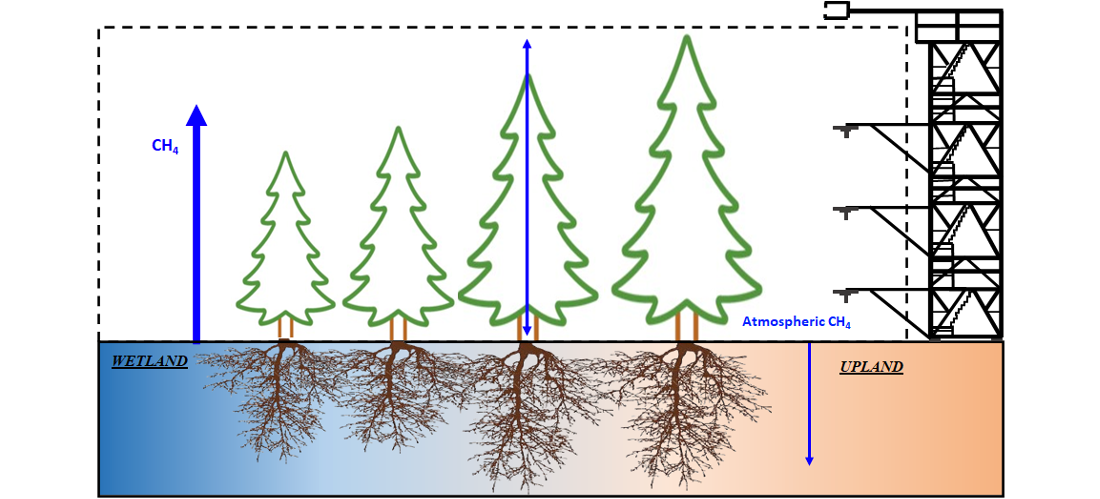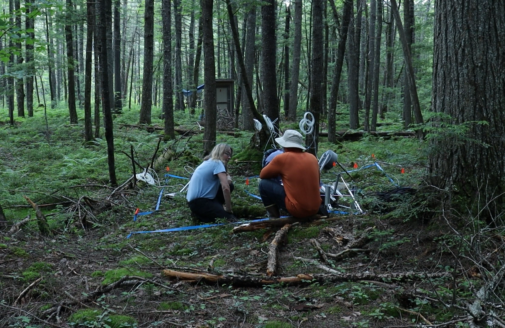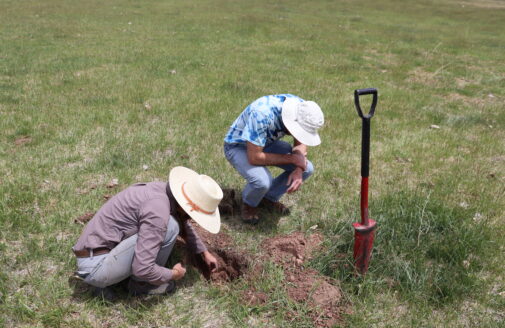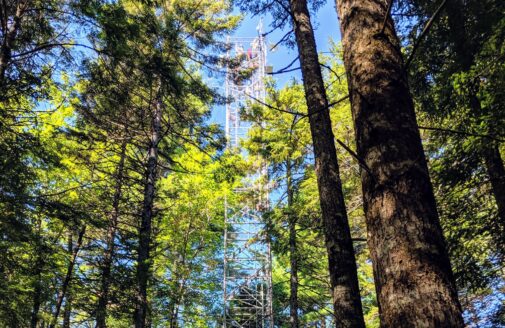photo by Dave Hollinger
- Jennifer D. Watts Arctic Program Director, Associate Scientist
- Kathleen Savage Senior Research Scientist
- Zoë Dietrich Research Assistant
- Shawn Fraver Associate Professor of Forest Ecology, University of Maine
- Debjani Sihi Assistant Professor, Emory University
- Hinsby Cadillo-Quiroz Associate Professor, Arizona State University
- Xiaofeng Xu Associate Professor of Ecology, San Diego State University
- David Hollinger Research Plant Physiologist, USDA Forest Service
- Andrew Ouimette Ecologist, USDA Forest Service
Methane is second only to carbon dioxide (CO2) in its contribution to human-induced climate change, thanks to its global warming potential—34x greater than CO2.
However, we understand very little about methane flux in forests, the processes and feedbacks that drive it, and how methane emissions or uptake will evolve with a changing climate.
Our Work
At the Howland Research Forest, ME, we are taking on this priority for biological research and improving methane flux models. Our innovative, multi-scale, and cross-disciplinary study is identifying the conditions and mechanisms driving methane sink/source activity across soil moisture gradients in northern forests.
Led by Woodwell Climate Research Center, in collaboration with the University of Maine, Emory University, Arizona State University, San Diego State University, and the USDA Forest Service, this research uses new DNA/RNA sequencing techniques that allow us to study microbial traits. Measuring these traits across different environmental conditions ultimately helps us learn how microbes’ sequestration of methane in sub-boreal forests may be offsetting methane emitters globally, and how this may change under future climate conditions. The Howland Research Forest serves as a case study to identify drivers and functional relationships across wet to dry soils, and from soils to canopy.
Research area

This conceptual diagram shows fluxes of methane (CH4) between wetland and dry upland areas within a sub-boreal forest. Soil micro-organisms produce methane under wet conditions, while others consume methane under dry conditions. The eddy covariance tower shown on the right of the diagram measures the net exchange of methane to determine if the area is a source (release) or sink (uptake) of methane.
Our work at Howland Forest has three main components:
- Belowground (soils) to aboveground (trees) processes: Using both field and lab experiments, we are measuring methane fluxes, microbial traits, and environmental conditions below and above ground in the forest. This will help us identify the role of microbial processes and physical drivers in regulating methane flux, and we can compare these measurements to those taken by the forest’s eddy flux tower to better describe the overall movement of methane within the landscape.
- Improving process-based ecosystem models: Our field and lab observations will ultimately guide much-needed improvement of ecosystem models such as the Microbial Model for Methane Dynamics (M3D)-DAMM and Community Land Model-Microbe process models.
- Predictions across space and time: We will apply our laboratory and field data toward improving models that identify both seasonal and annual methane sink/source activity at Howland, from present to 2100.
Our Impact
Our study is providing new insights for carbon budgets into how methane uptake in northern forests may be offsetting methane emissions, as well as how these systems might shift to net emission under projections of increasing precipitation across the northeastern region of the United States. We are ensuring that this improved understanding reaches broad audiences through a range of activities:
- Global methane workshop (2024): We are hosting a three-day methane workshop at the UMaine campus and at Howland forest to promote co-production of knowledge, bringing together global experts in methane. Scientists from the Arctic to the Tropics will discuss how they can better integrate field-lab-model approaches to improve understanding of ecosystem gas exchange at field-to-global scales.
- Local outreach to high schools: Our team is coordinating “scientist in the classroom” outreach visits to local high schools, and inviting local Maine students and the public to an open house at the Howland Research Forest to learn about this research.
- Training the next generation of scientists: This project directly supports the cross-disciplinary training of 2 Postdocs, 2 Ph.D. students, and at least 8 undergraduate students, primarily from underrepresented groups. Interested students can reach out to Kathleen Savage.
Phenology Cam
Howland Research Forest is part of an international phenology camera network, hosted at Northern Arizona University. There are two cameras located at the Main tower site.
See the view from Howland Forest’s main tower.
See the view from Howland Forest’s north tower.
This project is supported by the National Science Foundation Division of Environmental Biology.
This material is based upon work supported by the U.S. National Science Foundation under Award No. NSF 2208655. Any opinions, findings, conclusions or recommendations expressed in this material are those of the author(s) and do not necessarily reflect the views of the National Science Foundation.














